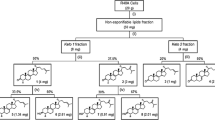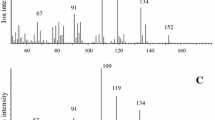Abstract
19-Azasqualene-2,3-epoxide was more inhibitory than the corresponding N-oxide against 2,3-oxidosqualene cyclase (OSC) solubilized from Saccharomyces cerevisiae (IC50 7±2 and 25±5 μM, respectively). Both compounds showed a reversible, noncompetitive-type inhibition on solubilized OSC. Different inhibitory properties between the compounds were especially evident when measuring [14C]acetate incorporation into nonsaponifiable lipids extracted from treated cells. In cells treated with 19-azasqualene-2,3-epoxide at 30 μM, the radioactivity associated with the oxidosqualene fraction, which was negligible in the controls, rose to over 40% of the nonsaponifiable lipids, whereas it remained at a slightly appreciable level in cells treated with the N-oxide derivative under the same conditions. 19-Azasqualene-2,3-epoxide was also more effective than the N-oxide as a cell growth inhibitor (minimal concentration of compound needed to inhibit yeast growth: 45 and >100 μM, respectively). The two inhibitors underwent different metabolic fates in the yeast: while 19-azasqualene-2,3-epoxide did not undergo any transformation, its N-oxide was actively reduced to the corresponding amine in whole and in “ultrasonically stimulated” cells. The N-oxide reductases responsible for this transformation appear to be largely confined within the microsomal fractions and require NADPH for their activity. A possible relationship between the inhibitory properties of the two compounds and their metabolic fates is discussed.
Similar content being viewed by others
Abbreviations
- IC50 :
-
concentration of inhibitor that reduced the enzymatic conversion of 2,3-oxidosqualene to lanosterol by 50%
- NMR:
-
nuclear magnetic resonance
- OS:
-
2,3-oxidosqualene
- OSC:
-
2,3-oxidosqualene-lanosterol cyclase
- TLC:
-
thin-layer chromatography
References
Abe, I., Rohmer, M., and Prestwich, G.D. (1993) Enzymatic Cyclization of Squalene and Oxidosqualene to Sterols and Triterpenes, Chem. Rev., 93, 2189–2206.
Van Tamelen, E.E. (1982) Bioorganic Characterization and Mechanism of the 2,3-Oxidosqualene→Lanosterol Conversion, J. Am. Chem. Soc. 104, 6480–6481.
Nes, W.D., Koike, K., Jia, Z., Sakamoto, Y., Satou, T., Nikaido, T., and Griffin, J.F. (1998) Cyclosterol Analysis by 1H and 13C NMR, Crystallographic Observations, and Molecular Mechanics Calculations, J. Am. Chem. Soc. 120, 5970–5980.
Moore, W.R., and Schatzman, G.L. (1992) Purification of 2,3-Oxidosqualene Cyclase from Rat Liver, J. Biol. Chem. 267, 22003–22006.
Abe, I., Ebizuka, Y., Seo, S., and Sankawa, U. (1989) Purification of Squalene-2,3-epoxide Cyclase from Cell Suspension Cultures of Rabdosia japonica Hara, FEBS Lett. 249, 100–104.
Abe, I., Sankawa, U., and Ebizuka, Y. (1992) Purification and Properties of Squalene-2,3-epoxide Cyclase from Pea Seedlings, Chem. Pharm. Bull. 40, 1755–1760.
Abe, I., and Prestwich, G.D. (1995) Molecular Cloning, Characterization, and Functional Expression of Rat Oxidosqualene Cyclase cDNA, Proc. Natl. Acad. Sci. USA 92, 9274–9278.
Corey, E.J., Matsuda, S.P.T., and Bartel, B. (1994) Molecular Cloning, Characterization, and Overexpression of ERG7, the Saccharomyces cerevisiae Gene Encoding Lanosterol Synthase, Proc. Natl. Acad. Sci. USA 91, 2211–2215.
Buntel, C.J., and Griffin, J.H. (1992) Nucleotide and Deduced Amino Acid Sequences of the Oxidosqualene Cyclase from Candida albicans, J. Am. Chem. Soc. 114, 9711–9713.
Corey, E.J., Matsuda, S.P.T., and Bartel, B. (1993) Isolation on an Arabidopsis thaliana Gene Encoding Cycloartenol Synthase by Functional Expression in a Yeast Mutant Lacking Lanosterol Synthase by the Use of a Chromatographic Screen, Proc. Natl. Acad. Sci. USA 90, 11628–11632.
Xiao, X., and Prestwich, G.D. (1991) 29-Methylidene-2,3-oxidosqualene: A Potent Mechanism-Based Inactivator of Oxidosqualene Cyclase, J. Am. Chem. Soc. 113, 9673–9674.
Abe, I., Liu, W., Oehlschlager, A.C., and Prestwich, G.D. (1996) Mechanism-Based Active Site Modification of Oxidosqualene Cyclase by Tritium-Labeled 18-Thia-2,3-oxidosqualene, J. Am. Chem. Soc. 118, 9180–9181.
Corey, E.J., Cheng, H., Baker, H., Matsuda, S.P.T., Li, D., and Song, X. (1997) Studies of the Substrate Binding Segments and Catalytic Action of Lanosterol Synthase. Affinity Labeling with Carbocations Derived from Mechanism-Based Analogs of 2,3-Oxidosqualene and Site-Directed Mutagenesis Probes, J. Am. Chem. Soc. 119, 1289–1296.
Ceruti, M., Rocco, F., Viola, F., Balliano, G., Milla, P., Arpicco, S., and Cattel, L. (1998) 29-Methylidene-2,3-oxidosqualene Derivatives as Stereospectific Mechanism-Based Inhibitors of Liver and Yeast Oxidosqualene Cyclase, J. Med. Chem. 41, 540–554.
Eisele, B., Budzinski, R., Muller, P., Maier, R., and Mark, M. (1997) Effects of a Novel 2,3-Oxidosqualene Cyclase Inhibitor on Cholesterol Biosynthesis and Lipid Metabolism in vivo, J. Lipid Res. 38, 564–575.
Zheng, Y.E., Dodd, D.S., Oehlschlager, A.C., and Hartman, P.G. (1995) Synthesis of Vinyl Sulfide Analogs of 2,3-Oxidosqualene and Their Inhibition of 2,3-Oxidosqualene Lanosterol Cyclase, Tetrahedron 51, 5255–5276.
Cattel, L., Ceruti, M., Balliano, G., Viola, F., Grosa, G., Rocco, F., and Brusa, P. (1995) 2,3-Oxidosqualene Cyclase: from Azasqualenes to New Site-Directed Inhibitors, Lipids 30, 235–246.
Balliano, G., Viola, F., Ceruti, M., and Cattel, L. (1988) Inhibition of Sterol Biosynthesis in Saccharomyces cerevisiae by N,N-Diethylazasqualene and Derivatives, Biochim. Biophys. Acta 959, 9–19.
Ceruti, M., Balliano, G., Viola, F., Cattel, L., Gerst, N., and Schuber, F. (1987) Synthesis and Biologial Activity of Azasqualenes, Bis-azasqualenes and Derivatives, Eur. J. Med. Chem. 22, 199–208.
Viola, F., Brusa, P., Balliano, G., Ceruti, M., Boutaud, O., Schuber, F., and Cattel, L. (1995) Inhibition of 2,3-Oxidosqualene Cyclase and Sterol Biosynthesis by 10-and 19-Azasqualenes Derivatives, Biochem. Pharmacol. 50, 787–796.
Bradford, M.M. (1976) A Rapid and Sensitive Method for the Quantitation of Microgram Quantities of Protein Utilizing the Principle of Protein-Dye Binding, Anal. Biochem. 72, 248–254.
Bujons, J., Guajardo, R., and Kyler, K.S. (1988) Enantioselective Enzymatic Sterol Synthesis by Ultrasonically Stimulated Baker’s Yeast, J. Am. Chem. Soc. 110, 604–606.
Peterson, G.L. (1977) A Simplification of the Protein Assay Method of Lowry et al. Which Is More Generally Applicable, Anal. Biochem. 83, 346–356.
Rickwood, D., Dujon, B., and Darley-Usmar, V.M. (1988) Yeast Mitochondria, in Yeast, A Practical Approach (Campbell, I., and Duffus, J.H., eds.), pp. 185–247, IRL Press, Oxford.
Lineweaver, H., and Burk, D. (1934) The Determination of Enzyme Dissociation Constants, J. Am. Chem. Soc. 56, 658–666.
Lindsey, S., and Harwood, H.J., Jr. (1995) Inhibition of Mammalian Squalene Synthetase Activity by Zaragozic Acid A Is a Result of Competitive Inhibition Followed by Mechanism-Based Irreversible Inactivation, J. Biol. Chem. 270, 9083–9096.
Ceruti, M., Rocco, F., Viola, F., Balliano, G., Dosio, F., and Cattel, L. (1993) Synthesis and Biological Activity of 19-Azasqualene 2,3-Epoxide as Inhibitor of 2,3-Oxidosqualene Cyclase, Eur. J. Med. Chem. 28, 675–682.
Ceruti, M., Grosa, G., Rocco, F., Dosio, F., and Cattel, L. (1994) A Convenient Synthesis of [3-3H]Squalene and [3-3H]-2,3-Oxidosqualene, J. Labelled Compd. Radiopharm. 34, 577–585.
Balliano, G., Milla, P., Ceruti, M., Carrano, L., Viola, F., Brusa, P., and Cattel, L. (1994) Inhibition of Sterol Biosynthesis in Saccharomyces cerevisiae and Candida albicans by 22,23-Epoxy-2-aza-2,3-dihydrosqualene and the Corresponding N-Oxide, Antimicrob. Agents Chemother. 38, 1904–1908.
Nes, W.D., and Parish, E.J. (1988) Metabolism of 2(RS),3-Epiminosqualene to 24(RS),25-Epiminolanosterol by Gibberella fujikuroi, Lipids 13, 375–376.
Cattel, L., Ceruti, M., Balliano, G., Viola, F., Grosa, G., and Schuber, F. (1989) Drug Design Based on Biosynthetic Studies: Synthesis, Biological Activity, and Kinetics of New Inhibitors of 2,3-Oxidosqualene Cyclase and Squalene Epoxidase, Steroids 53, 363–391.
Cattel, L., and Ceruti, M. (1997) Inhibitors of 2,3-Oxidosqualene Cyclase as Tools for Studying the Mechanism and Function of the Enzyme, in Biochemistry and Function of Sterols (Parish, E.J., and Nes, W.D., eds.), pp. 1–21, CRC Press, Boca Raton.
Kitamura, S., and Tatsumi, K. (1984) Reduction of Tertiary Amine N-Oxides by Liver Preparations: Function of Aldehyde Oxidase as a Major N-Oxide Reductase, Biochem. Biophys. Res. Commun. 121, 749–754.
Balliano, G., Viola, F., Ceruti, M., and Cattel, L. (1992) Characterization and Partial Purification of Squalene-2,3-oxide Cyclase from Saccharomyces cerevisiae, Arch. Biochem. Biophys. 293, 122–129.
Leber, R., Zinser, E., Zellnig, G., Paltauf, F., and Daum, G. (1994) Characterization of Lipid Particles of the Yeast, Saccharomyces cerevisiae, Yeast 10, 1421–1428.
Zinser, E., Sperka-Gottlieb, C.D.M., Fasch, E.-V., Kohlwein, S.D., Paltauf, F., and Daum, G. (1991) Phospholipid Synthesis and Lipid Composition of Subcellular Membranes in the Unicellular Eukaryote Saccharomyces cerevisiae, J. Bacteriol. 173, 2026–2034.
Zinser, E., Paltauf, F., and Daum, G. (1993) Sterol Composition of Yeast Organelle Membranes and Subcellular Distribution of Enzymes Involved in Sterol Metabolism, J. Bacteriol. 175, 2853–2858.
Leber, R., Landl, K., Zinser, E., Ahorn, H., Spök, A., Kohlwein, S.D., Turnowsky, F., and Daum G. (1998) Dual Localization of Squalene Epoxidase, Erg 1p, in Yeast Reflects a Relationship Between the Endoplasmic Reticulum and Lipid Particles, Mol. Biol. Cell. 9, 375–386.
Author information
Authors and Affiliations
Corresponding author
About this article
Cite this article
Milla, P., Viola, F., Ceruti, M. et al. 19-Azasqualene-2,3-epoxide and its N-oxide: Metabolic fate and inhibitory effect on sterol biosynthesis in Saccharomyces cerevisiae . Lipids 34, 681–688 (1999). https://doi.org/10.1007/s11745-999-0413-5
Received:
Revised:
Accepted:
Issue Date:
DOI: https://doi.org/10.1007/s11745-999-0413-5




